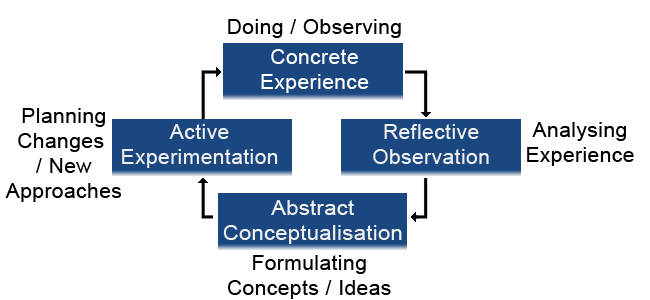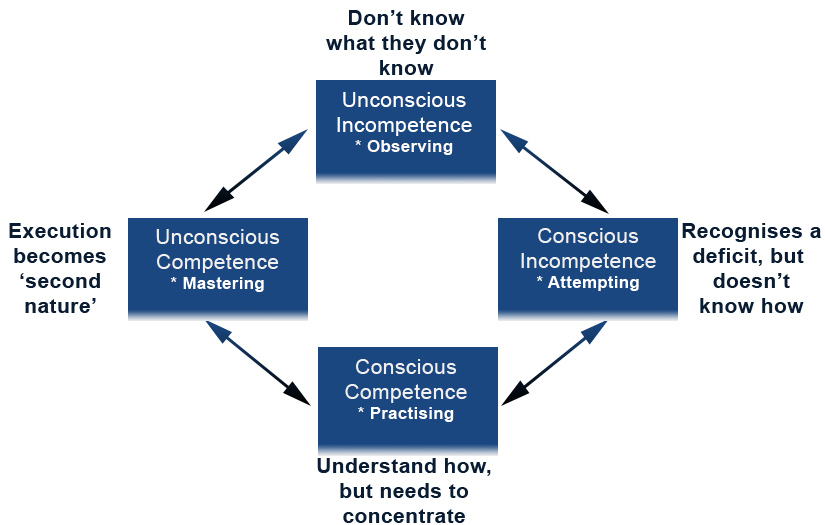Clinical learning and teaching
This section provides a brief overview of two well-known models that explain how people learn in situations such as the workplace, and how people supervising learners can develop their practices.
Experiential Learning
Kolb's theory of Experiential Learning (1984) is one of the best known models for understanding experiential learning. The model, or cycle, comprises four different stages of learning from experience:
- Concrete Experience (the learner doing/observing 'something')
- Reflective Observation (analysing and discussing the experience)
- Abstract Conceptualisation (making sense of the experience by drawing on relevant knowledge frameworks, and coming to conclusions about practice)
- Active Experimentation (implementing new understandings in practice, and starting the cycle again)

A key point:
- the cycle can be entered at any point, but all stages must be followed in sequence for successful learning to take place
Essentially this means that it is not sufficient to 'simply' have an experience in order to learn. It is necessary for learners to reflect on the experience, make generalisations and formulate new understandings which can then be applied in practice. The learner must make the link between the theory and action by planning, acting out, reflecting and relating it back to the theory.
Atherton, J.S. (2013). Learning and Teaching; Experiential Learning [On-line: UK] retrieved 9 February 2016 from http://www.learningandteaching.info/learning/experience.htm
Stages of becoming competent
Initially described as "Four Stages for Learning Any New Skill", the theory was developed by Noel Burch in the 1970s, and popularised in medical education by Peyton (1998). The model - also called the Conscious Competence Ladder - suggests that individuals are initially unaware of how little they know, or unconscious of their incompetence. As they recognize their incompetence, they consciously acquire a skill, then consciously use it. Eventually, when the skill can be undertaken without being consciously thought through the individual is said to have acquired unconscious competence.
Some more about each of the levels:
- Unconscious incompetence - individuals do not understand or know how to do something and do not necessarily recognize the deficit. They must recognise their own incompetence, and the value of the new skill, before moving on to the next stage.
- Conscious incompetence - individuals lack understanding or know-how, but do recognize a deficit, as well as the value of a new skill in addressing the deficit. Making mistakes can be integral to the learning process at this stage.
- Conscious competence - individuals understand or know how to do something. However, demonstrating the skill or knowledge requires concentration. There is heavy conscious involvement in executing the new skill.
- Unconscious competence - a skill has become "second nature" and can be performed easily and while executing another task.

Three key points:
- Repeated practice is needed to become competent with a skill/s - and can take time.
- Practice is essential to retain unconscious competence with a skill/s - this can be lost if people don't have sufficient opportunity to use their new skills regularly.
- Context is also important - depending on the similarity of a new clinical setting or new skill to individuals' previous experience, they may go 'back' to a lower level of competence until they have had the opportunity to develop the new understandings that are required.
Peyton JWR (1998) Teaching and Learning in Medical Practice. Manticore Europe, Rickmansworth.